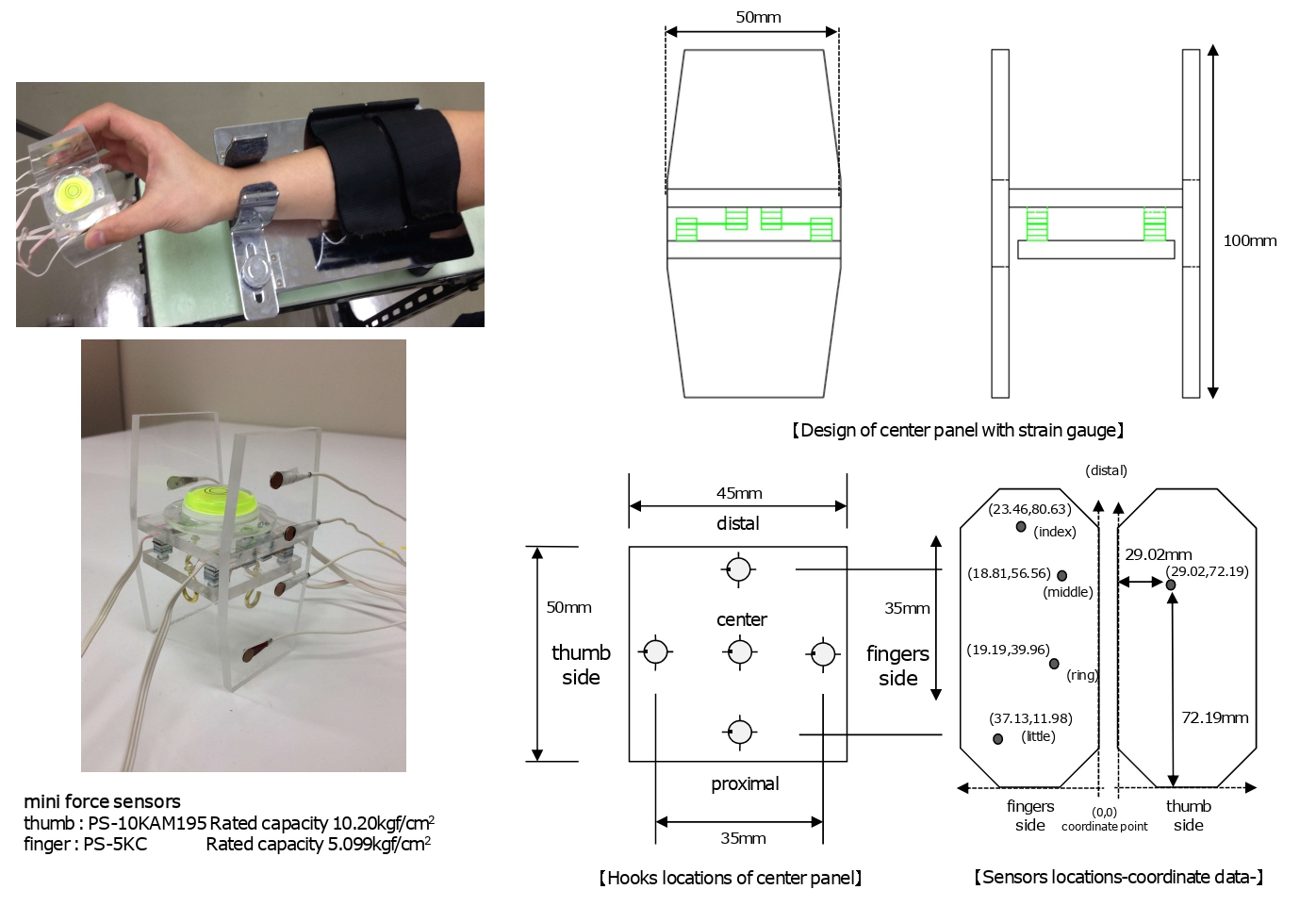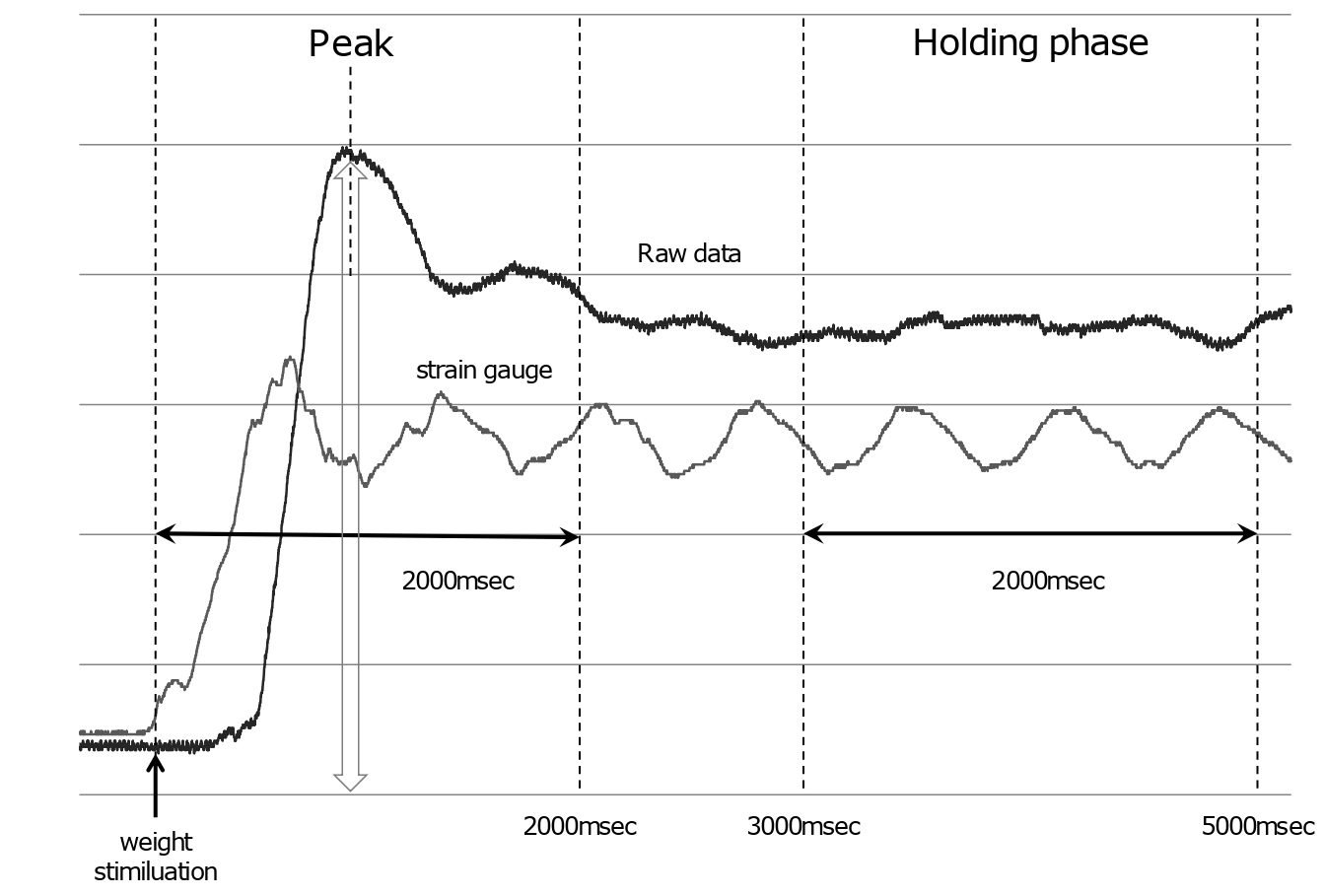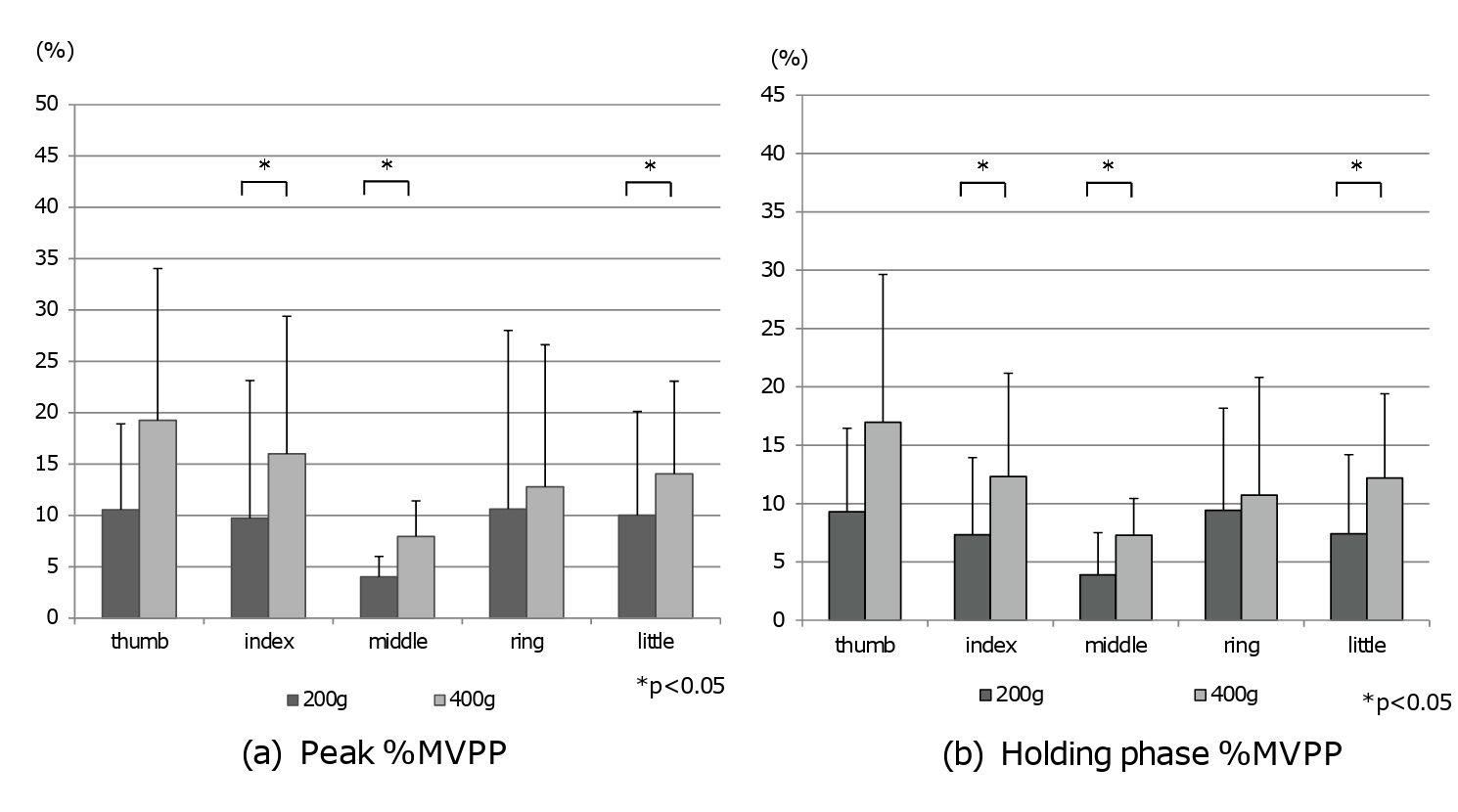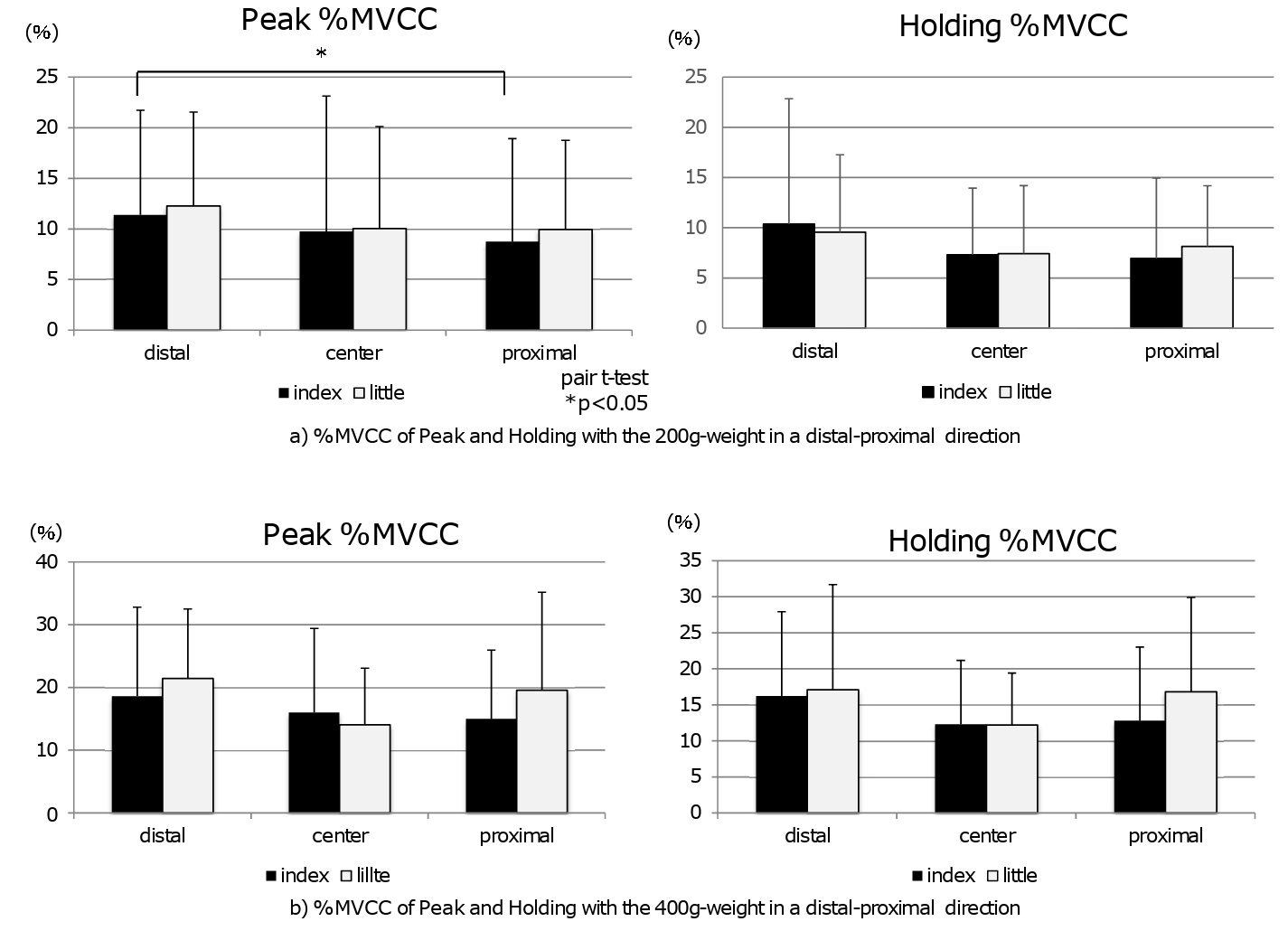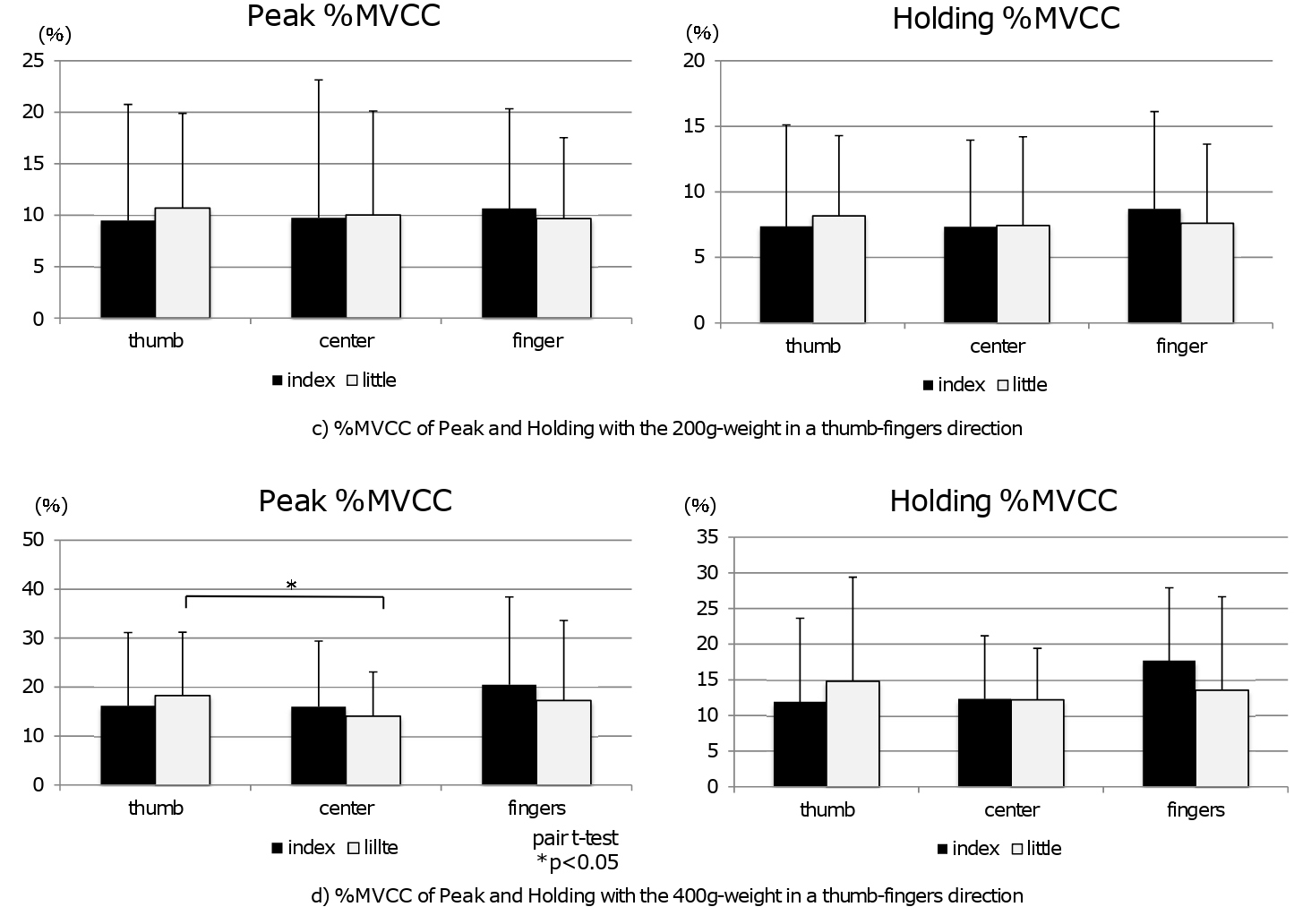Abstract
Objective: The purpose of this study is to investigate the finger functions while accomplishing the active operation of using a prismatic object. We measured each finger pressure toward the object when the center of gravity changes the position toward distal, proximal, thumb side and finger side.
Method: The Maximal Voluntary Prehension Power (MVPP) was measured for 10 female volunteers respectively. Also, the finger pressure when changing the positions of center of gravity was also measured. The loads were set at 200 g and 400 g, and were suspended at five positions. The fingers pressures were measured over all trials and the %MVPP was calculated and analyzed.
Result: When the loads were changed from the center position to the distal and proximal side, %MVPP of index finger especially increased in the distal side. In the proximal side, %MVPP of little finger increased more than center position. When the load positions were changed from center to thumb side and finger side, %MVPP of the little finger increased in the thumb side of center of gravity and %MVPP of the index finger increased in the finger side of center of gravity due to the rotation torque toward pronation and supination.
Discussion: From the results, we found that each finger had an interaction of finger function and finger coordinated motion control from the temporal changing of finger pressure and %MVPP. The change in center of gravity direction correlated with providing patterns of each finger pressure and %MVPP.
Keywords
Finger function, Active manipulation, Center of gravity
Introduction
We grasp and manipulate various types of objects during activities of daily living. To explain how we do this in a stable manner, a neural mechanism has been proposed that involves judging the position of the object and its characteristics (e.g., size, shape, material, and weight), executing the motor program based on sensory information, and feeding back information on whether the motions were executed properly [1-4]. Based on the notion that adjusting pinch force is essential for smoothly executing intended movements, we previously examined the precision of adjustments in pinch force made during tasks, using the standard deviation in error in relation to the target object as an index, and we revealed characteristics of active adjustment: the characteristic (i.e., speed) of the object and the point at which the increase and decrease of the force was switched affected the precision of the adjustment [5].
Recent studies have investigated the distribution of digit force and the function of each digit during multidigit prehension and manipulation of an object, as in actual manipulation of a tool [6-9]. Studies that examined the change in digit force distribution on the object with disturbance torque have shown that the digit force was exerted in a direction to generate the moment against the torque [10-14]. Changes in digit force distribution in response to internal factors (e.g., angle or vertical movement of the object) and external factors (e.g., changes in object weight) were confirmed and were similar to the functional characteristics seen with a pinching motion using the thumb and index finger [15,16]. It was also shown that the direction of upper limb movement and gravity influenced the execution of digit force [17-19]. When the weight of the object changed over time, the experience acquired immediately before the change influenced the execution of digit force and the safety margin [20,21]. In these previous studies, however, the contact point of each finger with the object was not determined based on daily life situations, and the digit force measured was used solely for examining digit force distribution, without accounting for differences in the maximum force of each digit. It is unlikely that such simple force distribution represents functional force distribution.
The purpose of this study was to reveal how digits respond, and consequently how the digit force distribution changes, when the center of gravity of the grasped object moves vertically and horizontally. This happens in real life when grasping an object containing a fluid, and it requires complex manipulation. We used the digit force output rate (proportion of the digit force measured to maximum digit force) to examine functional roles of the fingers.
Methods
Participants
The participants were 10 healthy female adults (mean age, 22.1 ± 1.2 years). All were right-handed with a mean Edinburgh Handedness Inventory score of 97.7 ± 4.85. None had motor or sensory function impairment in the upper limbs or a history of neuromuscular disease or orthopedic surgery in the forearms or digits. The explanation of the study was provided to participants in writing, and informed consent was obtained before commencing the study. This study was approved by the Ethics Committee of Sapporo Medical University.
Apparatus
The object previously used by Nakamura et al for a prehension experiment, an H-shaped object made of acrylic board [22], was modified for use in this study. The size of the side panel was 50 mm × 100 mm × 5 mm. To eliminate possible contact with the digits and consequent interference with the adjustment of digit force, 4 corners of the panels were cut off to obtain octagonal panels. A sensor (Kyowa Electronic Instruments Co., Ltd, Tokyo, Japan) for detecting the timing and position of weight load was placed in the center of the panel. In order to change the center of gravity, hooks were attached to the center of the panel in 5 locations: center, and midpoints of the top, bottom, right, and left sides (Figure 1). The following miniature pressure sensors (Kyowa Electronic Instruments Co., Ltd), which were previously tested and calibrated for use for digit force measurement, were attached to the object: PS-10KAM195 (rated capacity, 10.20 kgf/cm2; rated output, 1 mV/V) for the thumb and PS-5KC (rated capacity, 5.099 kgf/cm2; rated output, 1 mV/V) for other digits.
Figure 1: Experimental setup.
The positions of the sensors were determined as described previously [22]. Briefly, the mean coordinate of the center of contact of the distal pulp of each digit was obtained in a natural grasping position. The errors from the mean coordinate were confirmed to be within the sensing surface of the sensor (diameter, 6 mm). The lengths of the participants’ digits in this study fell within the range of the mean ± SD of the participants in the previous study [22]. The total weight of the model object was 116.7 g.
Experimental procedure
The length of the participants’ hands and fingers were examined. The pulps of the right digits were wiped thoroughly with alcohol swabs. The participants sat on a stool and the forearm was placed in a neutral position in a fixation stand. The maximum voluntary pinch power (MVPP) of each digit was measured as the participant grasped the object on the table in front of them. Measurements were taken 3 times. After adequate rest time to prevent tiredness, experiments were completed using two weight loads (200 g and 400 g) and different centers of gravity.
Before starting the experiment, participants practiced grasping the object with a 200-g and a 400-g weight attached to each of the 5 positions of the center of gravity. Then, the 5 positions were tested, in random order, in one experimental trial that was repeated 3 times with each participant. The experiment using the 200-g weight was performed before the experiment using the 400-g weight to eliminate the effect of the change in safety margin. Adequate rest time was allowed between the measurements to eliminate the effect of fatigue.
The object with weight attached was held stationary in a horizontal position in air for 10 s, and digit forces were recorded using a vital sign recording program (VitalRecorder; Kissei Comtec Co., Ltd., Nagano, Japan) at a sampling frequency of 1 kHz (Figure 1).
Data analysis
All data recorded by the VitalRecorder were analyzed using a multipurpose vital signal analysis program (BIMUTAS II; Kissei Comtec Co., Ltd, Nagano, Japan) and saved as Microsoft Office Excel 2010 files.
The highest of the 3 MVPP measurements taken was analyzed in this study for %MVPP calculation. To analyze digit force with a change in the object’s center of gravity, the peak force detected in a 0-2000 msec period after weight load were obtained (initial peak force). Then, the mean force of each digit when the object was held at a horizontal position (i.e., the holding phase 3000-5000 msec after weight load) was calculated. The holding phase varied in previous studies, such as 10000-15000 msec in a study by Johannson et al. [2], 5000-7000 msec by Kinoshita et al. [8], and 2000-5000 msec by Yao et al. [16]. The present study used a holding phase of 3000-5000 msec to obtain the mean force of each digit (Figure 2) because the mean time to stable digit force exertion obtained from the randomly extracted data fell into a holding phase of 3000- 5000 msec, as reported recently.
Figure 2:?Data analysis. The peak force detected in a 0-2000 msec period after weight load were obtained initial peak force. The present study used a holding phase of 3000-5000 msec to obtain the mean force of each digit because the mean time to stable digit force exertion obtained from the randomly extracted data fell into a holding phase of 3000-5000 msec, as reported recently.
This study examined the initial peak force, and mean digit force and %MVPP in the holding phase. Previous studies calculated the proportion of force of each digit to the total force of all digits loaded on the object [8,15], but that approach does not account for differences in muscle strength and MVPP among the digits and so the contribution of small finger pressure during prehension would be low. However, we thought that that even if finger pressure were small, when the involvement of the finger is high, it may play an important role in the manipulation, and we therefore used %MVPP as an index of the involvement of each digit in manipulation. The initial peak force, the mean digit force in the holding phase, and proportion of these to MVPP (%MVPP) were compared among the digits, different points for the center of gravity, and presence/ absence of the information for the center of gravity using a one-way ANOVA. When significance was detected, multiple comparison was performed using the Tukey- Kramer test. A paired t-test was used to examine changes in digit force in response to the changes in the object’s center of gravity. Statistical analysis was performed using SPSS 12.0 for Windows, with statistical significance set at p<0.05.
Results
Five-digit prehension: characteristics of the distribution of digit force; initial peak force with the center of gravity at the center of the grasped object
With the 200-g weight, %MVPP values of the initial peak force were 10.56% for the thumb, 9.74% for the index finger, 4.02% for the middle finger, 10.63% for the ring finger, and 10.02% for the little finger, indicating differences in involvement of the individual digits. The involvement of the middle finger was likely to be low, and the degree of involvement was similar between the ring and little fingers (Figure 3).
Figure 3: Characteristics of the distribution of digit force – 200g weight vs 400g weight at the center. Compared with %MVCC of 200g-weight and 400g-weight, it showed a significant different in the index, middle finger and little finger.
When the 400-g weight was used, %MVPP values tended to be higher than when the 200-g weight was used. Involvement of the ring finger appeared to be stronger than that of the little finger with the 200-g weight, but this trend was reversed with the 400-g weight. Increases in %MVPP values with an increase in weight load were significant for the index finger (p=0.014, t-test), middle finger (p=0.022), and little finger (p=0.047; Figure 4a).
Figure 4: Changes in digit force distribution with changes in the object’s center of gravity.
Increases in digit force and %MVPP were attributed to changes in weight load. When the timing of the initial peak force was compared, it was earliest for the index finger with the 200-g weight but for the little finger with the 400- g weight.
Five-digit prehension: characteristics of the distribution of digit force; in the holding phase with the center of gravity at the center of the grasped object
With the 200-g weight, the thumb exerted the largest digit force, followed in order by the index, middle, ring, and little fingers, indicating that force distribution in the holding phase was roughly similar to the time of peak force; in other words, the force distribution was stable. The %MVPP of the index finger tended to be higher in the holding phase, but the relative relationships among the other digits at the time of peak force were retained in the holding phase.
Similarly, with the 400-g weight, the trend in the involvement of digits at the time of peak force was retained in the holding phase, although the involvement rates were smaller. As shown in Figure 4b, %MVPP values with the 400-g weight were higher than those with the 200-g weight for the index finger (p=0.022), middle finger (p=0.032), and ring finger (p=0.011).
Changes in digit force distribution with changes in the object’s center of gravity in a distal-proximal direction
Both digit force and %MVPP values for all digits were higher when the weight was loaded at the distal position of the object, irrespective of the weight loaded. No marked difference in digit force or %MVPP was observed when the weight was loaded at the proximal position, but the involvement of the little finger tended to be more prominent than that of the ring finger. There were significant increases in digit force (p=0.026; t-test) and %MVPP (p=0.019) for the index finger when the object’s center of gravity was moved in a distal direction with the 200-g weight. When the 400-g weight was used, a significant difference was seen between the distal and center positions (p=0.029) for the little finger in response to change in the distal direction (Figure 4c).
Changes in digit force distribution when the object’s center of gravity changed in the thumbfinger direction
When the 200-g weight was used and the loading position was moved in the thumb direction, increase in %MVPP was more prominent for the little finger than for the ring finger, and the %MVPP of the little finger tended to be higher than that of the index finger. When the 200-g weight was used and the loading position was moved in the finger direction, increase in %MVPP was more prominent for the index finger than for the ring and little fingers. With the 400-g weight, there tended to be a greater increase in %MVPP than with the 200-g weight. With the 200-g weight, differences in both digit force and %MVPP were not significant when the object’s center of gravity was changed, whereas with the 400-g weight, these differences were significant for the little finger (digit force p=0.006 and %MVPP p=0.026) when the center of gravity changed toward the thumb side (Figure 4d).
Discussion
This study examined changes in digit force that occur when the center of gravity of a grasped object changes to simulate the motion of fluid. We demonstrated that changes occur in the digit force distribution during 5-digit prehension when the object’s center of gravity changes from the center in a distal, proximal, thumb, or finger direction. The use of %MVPP as an index enables us to determine the actual degree of involvement of each digit in grasping and manipulating the object.
Relationships between the digits and the function of individual digits when the object’s center of gravity changes in a distal or proximal direction
When the center of gravity moved in a distal direction, digit forces and %MVPP values increased for all digits. When the center of gravity moved in a proximal direction, digit forces and %MVPP values did not change much, but %MVPP tended to be greater for the little finger than the ring finger. When the object’s center of gravity moves in a distal direction (in other words, when the center of gravity moves away from the palm), digit force is applied to reverse the torque of the object, and it is likely that strong pull-back force is generated, especially by the index finger. In weight lifting, joint moments and consequent muscle fatigue increase as the distance between the object to be lifted and the body increases [23], and this may explain our findings of increased digit force and %MVPP when the distance between the object and the hand increased (i.e., the center of the gravity moved in the distal direction). When the object’s center of gravity moved in a proximal direction (in other words, when the center of gravity moved toward the proximal part of the palm), the object was likely to be held in the horizontal position without increasing digit force or %MVPP. The torque of the object toward the proximal direction was reversed by the force generated by all digits, where pull-back forces of the ring and little fingers, and especially the ring finger (as shown by its higher involvement rate), were essential. In this study, participants knew in which direction the object’s center of gravity would move because they were told beforehand, and the involvement rate of the little finger increased according to the prediction. This suggests that the little finger is responsive to the direction of change in the object’s center of gravity.
Relationships between the digits and the function of individual digits when the object’s center of gravity changed in a direction toward the thumb and little finger
Digit force and %MVPP of the little finger increased when the object’s center of gravity moved toward the thumb, while those of the index finger increased when it moved toward the little finger. These findings are in good agreement with those of previous studies that examined changes in digit force in response to torque applied to the grasped object in the direction of pronation or supination of the forearm [11-14,17]. More precisely, to keep the object in a horizontal position, the force exerted by the little finger was increased to generate the supination torque as the object’s center of gravity moved toward the thumb (i.e., torque in the direction of pronation was applied to the object), while the force exerted by the index finger was increased to generate the pronation torque as the object’s center of gravity moved toward the little finger (i.e., the torque in the direction of supination was applied to the object). Increases in the force exerted by the little finger were more prominent with the 400-g weight than with the 200-g weight, suggesting that the functions of the digits become more prominent in manipulation when the object’s center of gravity changes.
Taken together, the findings of this study suggest that the middle and ring fingers, which are located centrally among the digits, contribute to the fixation of spatial orientation and position, while the index and little fingers play a dominant role in active manipulation when the object’s center of the gravity changes. These findings are in good agreement with those of previous studies where the index and little fingers contributed to the generation of torque, and the middle and ring fingers exerted forces depending on the torque generated and weight load applied [11-13]. Given that the digit force and %MVPP of the little finger increased, this digit is likely involved in the generation of force against a downward sliding object, while the index finger is likely involved in directional manipulation of the object regardless of its weight.
Digit forces and %MVPP values of the index and little fingers tended to be lower in the holding phase than at the time of peak force. This may represent the condition of the holding phase where these digits, which have independent extensor muscle and greater manipulation ability than the other digits, were ready for manipulation function. Although responses to changes in an object’s center of gravity in a distal-proximal direction have not been well studied, the index and little fingers are likely to be involved in force adjustment and manipulation in response to such changes in all directions, while the middle and ring fingers are involved in responding to the disturbance load and maintaining the spatial orientation of the object.
Acknowledgements
The authors would like to give special thanks to all the participants and staff who facilitated in the data collection. This paper was supported by the Sapporo Medical University Graduate School of Health Sciences.
Declaration of Interest
The authors report no conflicts of interest. The authors alone are responsible for the content and writing of paper.
References
2. Westling G, Johansson RS. Factors influencing the force control during precision grip. Experimental brain research. 1984 Jan;53(2):277-84.
3. Johansson RS, Westling G. Roles of glabrous skin receptors and sensorimotor memory in automatic control of precision grip when lifting rougher or more slippery objects. Experimental Brain Research. 1984 Oct;56(3):550-64.
4. Johansson RS. Sensory input and control of grip. InNovartis Foundation Symposium 1998 Jan 1 (pp. 45-58). Wiley.
5. Nakamura M, Hirota M, Nakamura M. Characteristics of Adjusting Precision Grip Strength -Relationship between coordination and pulp-to-pulp distance when applying and reducing pinch pressure. Japanses Journal of Occupational Therapy Research. 2013;16(1):23-30.
6. Amis AA. Variation of finger forces in maximal isometric grasp tests on a range of cylinder diameters.Journal of Biomedical Engineering. 1987 Oct 1;9(4):313-20.
7. Reilmann R, Gordon AM, Henningsen H. Initiation and development of fingertip forces during wholehand grasping. Experimental Brain Research. 2001 Oct 1;140(4):443-52.
8. Kjnoshita H, Kawai S, Ikuta K. Contributions and co-ordination of individual fingers in multiple finger prehension. Ergonomics. 1995 Jun 1;38(6):1212-30.
9. Taguchi H, Hase K, Maeno T. Analysis of the motion pattern and the learning mechanism for manipulating objects by human fingers. Nippon Kikai Gakkai Ronbunshu, C Hen/Transactions of the Japan Society of Mechanical Engineers, Part C. 2002 Jun 1;68(6):1647-54.
10. Zatsiorsky V, Gao F, Latash M. Prehension synergies: effects of object geometry and prescribed torques.Experimental Brain Research. 2003 Jan;148(1):77-87.
11. Zatsiorsky VM, Gregory RW, Latash ML. Force and torque production in static multifinger prehension: biomechanics and control. II. Control. Biological Cybernetics. 2002 Jul;87(1):40-9.
12. Zatsiorsky VM, Latash ML. Multifinger prehension: an overview. Journal of Motor Behavior. 2008 Sep 1;40(5):446-76.
13. Zatsiorsky VM, Latash ML. Prehension synergies. Exercise and Sport Sciences Reviews. 2004 Apr;32(2):75.
14. Latash ML, Friedman J, Kim SW, Feldman AG, Zatsiorsky VM. Prehension synergies and control with referent hand configurations. Experimental Brain Research. 2010 Apr;202(1):213-29.
15. Friedman J, Latash ML, Zatsiorsky VM. Prehension synergies: a study of digit force adjustments to the continuously varied load force exerted on a partially constrained hand-held object. Experimental Brain Research. 2009 Jul 1;197(1):1-3.
16. Sun Y, Zatsiorsky VM, Latash ML. Prehension of halffull and half-empty glasses: time and history effects on multi-digit coordination. Experimental Brain Research. 2011 Apr;209(4):571-85.
17. Latash ML, Shim JK, Gao F, Zatsiorsky VM. Rotational equilibrium during multi-digit pressing and prehension. Motor Control. 2004 Oct 1;8(4):392-404.
18. Smith MA, Soechting JF. Modulation of grasping forces during object transport. Journal of Neurophysiology. 2005 Jan;93(1):137-45.
19. Gao F, Latash ML, Zatsiorsky VM. Internal forces during object manipulation. Experimental Brain Research. 2005 Aug 1;165(1):69-83.
20. Augurelle AS, Penta M, White O, Thonnard JL. The effects of a change in gravity on the dynamics of prehension. Experimental Brain Research. 2003 Feb;148(4):533-40.
21. Augurelle AS, Smith AM, Lejeune T, Thonnard JL. Importance of cutaneous feedback in maintaining a secure grip during manipulation of hand-held objects. Journal of Neurophysiology. 2003 Feb 1;89(2):665-71.
22. Nakamura M, Katagiri K, Nakamura M. Determination Factors of Contact Positions during Grasping the Object with Thumb and Four Fingers. Japanses Journal of Occupational Therapy Research. 2012;15(2):27-33.
23. Sasaki M, Horio A, Wakasa M, Uemura S, Osawa Y. Influence of quadriceps femoris fatigue on low back load during lifting of loads at different distances from the toes. Journal of Physical Therapy Science. 2008;20(2):81-9.

